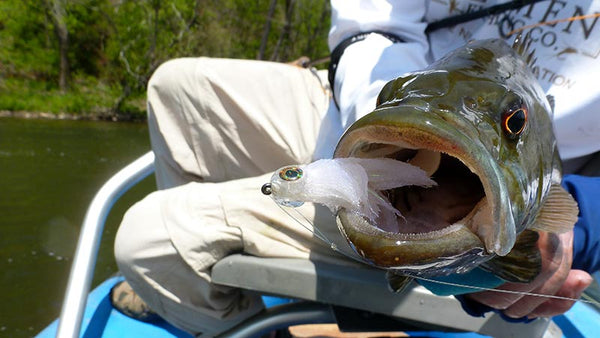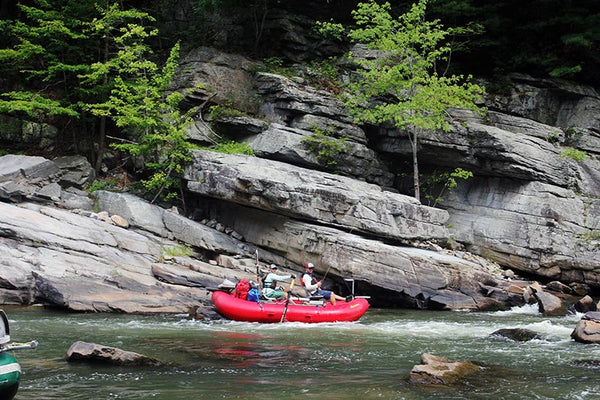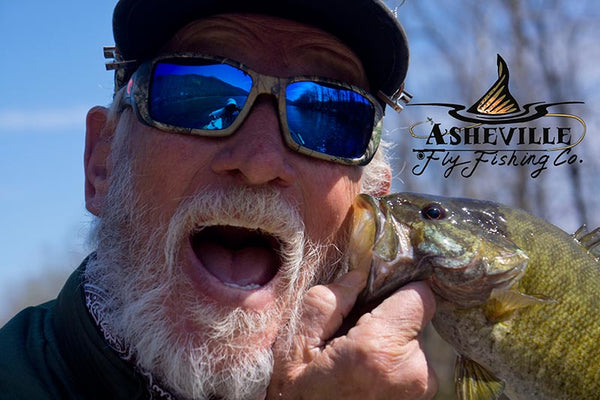Fly fishing: Smallmouth spawning psychology.


Photo courtesy of Asheville Fly Fishing Company.
Water temperature will tell you a great deal about where smallmouth bass are and what they're up to.
The first thing to do when you get on water you haven’t fished all winter, or even in the last week, is find the right water to fish.
As conditions underwater change, fish swim to find a comfy spot that suits their needs.
Learning to read water and pay attention to the finer details will enable you to identify holding spots quickly and increase your chances of being in the right place at the right time.
A quick breakdown looks like this:
Pre-spawn.
Water temperature: 45-50°F (7-10°C).
Fishing technique: Low 'n' slow.

Break out your toboggan and gloves.
On those early spring days before the Bradford pear trees bloom in the Southern Appalachian Mountains, the smallmouth bass can be found at the bottom of the deepest depressions of a river.
During this period, fish are recovering from cabin fever and looking for a sweetheart.
At the end of warmer days, fish will often move to shallow rocks that have been heating up in the sun all day to increase their body temperature.
Chocklett's Game Changer is a great fly to use during this time. When fishing shallow water in this situation, I like tying the Game Changer with extra weight and using a floating line rather than fishing an unweighted Game Changer with a sinking line.
This method gets better up-and-down motion and can dead-drift deep holes with the floating line acting as an anchor point.
Whatever you do, don’t forget to add a stinger hook…
Spawn.
Water temperature: 50-60°F (10-16°C).
Fishing technique: Stay home.

Photo courtesy of Asheville Fly Fishing Company.
One day without stinger hooks went like this:
We were throwing Game Changers tied in various colors on one of our favorite stretches of bronzeback water while doing some routine scouting to see where the fish were in their spawning phase.
We found fish in a section of river that had rock ledges running perpendicular to the current spanning the width of the river. The pockets of water between the ledges were 5’+ deep with sandy bottoms and water dropping over each ledge providing high oxygen levels. The ledges were close together and offered protection to spawning beds during high water periods.
We positioned the boat in a way that would allow us to fish the length of the shelf without spooking the fish.
The fish started swirling at the fly, making quick and aggressive strikes. Several fish were missed as a result of short strikes.
As an experiment, we stopped setting the hook altogether to see what the fish would do. The rest of the day we witnessed many large fish take the fly, carry it a short distance, and spit it out. This experience confirmed a couple things:
- We shalt never throw another Game Changer without a stinger hook again (it's been a lifechanger)!
- These were clearly not fish looking to feed, but fish guarding their beds.
Therein lies a decision you will face…
If you catch a fish as a result of the fish guarding its bed, you may injure, misplace, or kill the fish, thereby leaving the bed unprotected from predators.
Spawning success varies from year to year for many reasons. For example, high water and flooding at the wrong time can blow out spawning grounds and decrease spawning numbers.
Fish have a hard enough time surviving and reproducing, but fisheries everywhere are feeling the heat of the additional pressure from the ever-growing numbers of anglers.
This is perhaps the best reason to not beat up your favorite water during the smallmouth spawn.
Post-spawn.
Water temperature: 60-70°F (16-21°C).
Fishing technique: Topwater poppers and Game Changers.

Let the games begin!
Break out your best subsurface or topwater enticer and let the fish fly from the water.
This is one of the best times of the year to catch 3 lb. and bigger smallmouth while floating down a river in the Southern Appalachian Mountains.
When the fish come off the beds, they go straight to the buffet line.
While you’re out there serving it up for the fish, don’t forget (for the sake of keeping a healthy fishery) to go easy on them – they're vulnerable and probably a little tired.
Topwater.
Water temperature: 70°F+ (21°C+).
Fishing technique: Get 'er done.

Photo courtesy of Asheville Fly Fishing Company.
The right time for me personally is when the fish come to the surface to feed, which is now if you live near Asheville, North Carolina.
The first time it happened for me, I hit a 3 hour window where almost every cast resulted in an opportunity.
Whether they flashed, missed, or smashed the fly, I remember that session as one of those glorious moments in life, much like the bishop in the movie Caddyshack having the golf round of his life in a thunderstorm.

It was a special time. Find a time. Find your time.
Want more articles like this?
Join the Flymen Mailing List at the bottom of the page!
About Galen Kipar:
 Galen is a guide and owner at Asheville Fly Fishing Company. Galen’s obsession with water began in 1979 on the Van Duzen River in upstate California when he was 3 years old. He's originally from Georgia and grew up fishing for smallmouth, largemouth, striped bass, and trout in the Southern Appalachian Mountains. When not fishing, he composes and performs music, mostly about water and fishing. Follow Asheville Fly Fishing Company on Instagram, Facebook, and YouTube.
Galen is a guide and owner at Asheville Fly Fishing Company. Galen’s obsession with water began in 1979 on the Van Duzen River in upstate California when he was 3 years old. He's originally from Georgia and grew up fishing for smallmouth, largemouth, striped bass, and trout in the Southern Appalachian Mountains. When not fishing, he composes and performs music, mostly about water and fishing. Follow Asheville Fly Fishing Company on Instagram, Facebook, and YouTube.


Learn more on smallmouth fishing my own turf flies
Leave a comment